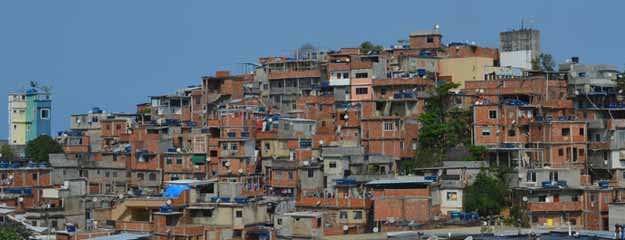Blog
The Largest Favelas in Rio de Janeiro
- Wednesday March 20th, 2024
- Posted by: Amanda Ennes
- Category: Rio de Janeiro

Not just famous for its stunning beaches and vibrant culture, Rio de Janeiro, Brazil, also boasts the favelas. They are integral to the city’s social fabric. Favelas in Rio de Janeiro, often depicted in movies and documentaries, are densely populated informal settlements that offer a unique glimpse into the daily lives of millions of Brazilians.
In Brazil, residents may prefer to identify favelas as ‘communities,’ reflecting their preference for the term.
Additional reading: The Favelas of Rio de Janeiro.
Table of Contents
ToggleUnderstanding the Favelas in Rio de Janeiro
Favelas in Rio de Janeiro are known for their colorful houses stacked on hillsides, creating a distinctive skyline. These communities have a rich history, dating back to the late 19th century when impoverished workers settled on hills surrounding the city center and richer areas in search of employment opportunities. Over the years, these settlements grew rapidly, giving rise to the favelas we see today.
Complexity and Diversity
The term “favela” encompasses a wide range of communities, each with its characteristics and challenges. While some favelas enjoy relatively well-developed infrastructure with access to basic amenities like electricity and water, others contend with significant deficiencies. Despite their differences, all favelas share a sense of resilience and community spirit.
Largest Favelas in Rio de Janeiro
Rocinha
Rocinha (map) is often regarded as the largest favela in Rio de Janeiro. It is home to over 70,000 residents according to the Brazilian Institute of Geography and Statistics. However, some local stats suggest the correct population for Rocinha is over 200,000 people. Situated between affluent neighborhoods, this sprawling community offers panoramic views of the city and is known for its bustling markets and vibrant street life. Despite its size, Rocinha faces socio-economic challenges, including inadequate infrastructure and limited access to public services.
Complexo do Alemão
Located in the North Zone of Rio de Janeiro, Complexo do Alemão (map) is a complex of favelas with a population exceeding 70,000 residents. However, informal statistics also believe the complex to be home to over 100,000 people. This community comprises favelas such as Adeus, Alemão, Fazendinha, Nova Brasília, and Palmeiras. In recent years, stakeholders have made efforts to improve security and infrastructure in the area, historically plagued by violence and crime. Today, Complexo do Alemão is home to diverse cultural initiatives and community-led projects aimed at fostering positive change.
Cidade de Deus
Made famous by the critically acclaimed film of the same name, Cidade de Deus (map) is one of Rio de Janeiro’s most well-known favelas. With a population of over 60,000 residents, this community has a vibrant cultural scene and is home to numerous artists and musicians. Despite its cultural richness, Cidade de Deus grapples with issues such as unemployment and inadequate public services.
Complexo da Maré
Complexo da Maré (map) is a complex of favelas located near Rio’s international airport, with a population estimated to be over 130,000 residents. It includes the favelas of Parque União, Nova Holanda, Vila do João, Baixa do Sapateiro, and others. It is one of the most densely populated areas in the city and faces various social and economic issues.
Jacarezinho
Situated in Rio’s North Zone, Jacarezinho (map) is one of the oldest and largest favelas in Rio de Janeiro, home to approximately 60,000 residents. Despite its size, the community faces challenges related to infrastructure and public services.
Community Initiatives and Resilience
Despite the challenges they face, favelas in Rio de Janeiro are also hubs of creativity and innovation. Community-led initiatives and grassroots organizations play a crucial role in addressing social issues and improving living conditions within these settlements. From educational programs to sustainable development projects, residents are actively involved in shaping the future of their communities.
Tourism and Ethical Considerations
While favelas in Rio de Janeiro attract curiosity from visitors, it is essential to approach favela tourism with sensitivity and respect. Many tour operators offer guided tours of favelas, providing insights into daily life while supporting local businesses and initiatives. However, it is crucial for visitors to be mindful of the communities they are visiting and to engage with them responsibly, taking into account that the place is home to thousands of real people.
Favelas in Rio de Janeiro are complex and diverse communities that offer a glimpse into the social realities of Brazil. From the sprawling hills of Rocinha to the cultural richness of Cidade de Deus, each favela has its own story to tell. By understanding and engaging with these communities respectfully, visitors can contribute to positive social change while gaining a deeper appreciation for the resilience and creativity of Rio’s favela residents.
Caminhos Language Centre is the largest and most exciting Portuguese school in Rio de Janeiro, Brazil. We have an excellent infrastructure, over 15 experienced Brazilian teachers, and a friendly multilingual support staff. We are the only school in Brazil able to offer Portuguese group courses throughout the year on 10 different levels. Moreover, our school also offers more than just Portuguese lessons for foreigners, we offer you the complete Rio de Janeiro experience. Every day we organize 100% free and fun activities for you to socialize and practice your Portuguese. We can also help you with a student visa for Brazil and accommodation in Rio de Janeiro. Follow us on Instagram for some Portuguese tips and news.


 Deutsch
Deutsch Français
Français Português
Português Español
Español
